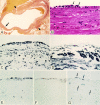Role of endothelial cell denudation and smooth muscle cell dedifferentiation in neointimal formation of human vein grafts after coronary artery bypass grafting: therapeutic implications
- PMID: 10618339
- PMCID: PMC1729291
- DOI: 10.1136/heart.83.1.69
Role of endothelial cell denudation and smooth muscle cell dedifferentiation in neointimal formation of human vein grafts after coronary artery bypass grafting: therapeutic implications
Abstract
Objective: To provide better insights into the genesis of neointimal thickening in human vein grafts early after surgery.
Design: Retrospective study.
Setting: Tertiary referral centre.
Subjects: 18 distal anastomotic sites of patent grafts, obtained at necropsy from eight patients who died over differing periods (ranging from two days to nine months) after the procedure.
Main outcome measures: Immunohistochemical evaluation of smooth muscle cell phenotype modulation in relation to proliferative activity.
Results: The earliest changes are characterised by loss of surface lining endothelial cells and insudation of blood corpuscular elements admixed with fibrin-platelet thrombus. At sites of injury vimentin positive and actin negative spindle shaped cells appear in the intima, while the related pre-existent media shows focal absence of actin positive smooth muscle cells. Proliferative activity colocalises at these sites. With time distinct neointimal thickening occurs, associated with disappearance of proliferative activity and a phenotypic shift of the smooth muscle cells.
Conclusions: The observation that luminal endothelial cell denudation, with insudation of the intima with blood elements, occurs in the very early stages suggests that these phenomena are responsible for the observed dedifferentiation of pre-existent smooth muscle cells, known to be a prerequisite for cell proliferation and the evolution of intimal thickening. It is likely, therefore, that platelet released growth factors play a pivotal role, which thus may provide a target for preventive pharmacological intervention.
Figures







References
MeSH terms
Substances
LinkOut - more resources
Full Text Sources
Medical
